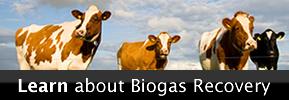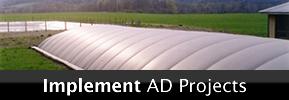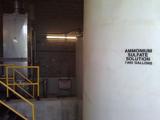AgSTAR: Biogas Recovery in the Agriculture Sector
AgSTAR promotes the use of biogas recovery systems to reduce methane emissions from livestock waste. In addition to producing biogas, anaerobic digestion systems can also help achieve other social, environmental, agricultural and economic benefits.
Anaerobic Digester Projects in the United States
![]() Dairy
Dairy ![]() Hog
Hog ![]() Poultry
Poultry ![]() Beef
Beef ![]() Mixed
Mixed
The colors and sizes of the circles indicate the types and numbers of animals that feed the digester at each project. Click the button (>>) at the top left of the map to show the detailed legend.
Codigestion – Added Organic Waste Benefits
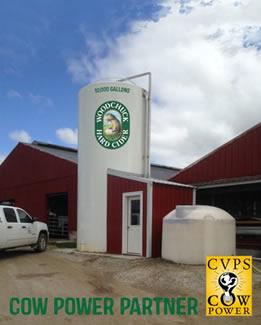 Photo of Woodcheck Cider tank at Monument FarmsMonument Farms Dairy in Weybridge, Vermont, installed an anaerobic digester to create bedding and generate renewable energy. Besides the addition of whey rinse water from Cabot Creamery’s cheese products, Monument recently began adding liquid waste (leese) from Vermont Hard Cider, LLC (producers of Woodchuck Hard Cider Exit). Monument Farms receives 3,800 gallons of liquid waste weekly from production activities for Woodchuck Hard Cider for co-digestion. The introduction of the Woodchuck Hard Cider waste produced two immediate benefits for the farm: helped liquefy the manure so it moves through the system easier; and increased the energy production by 20%! The increased production is critical because Monument Farms has a small digester and wants to get as much energy out of the digestion as possible. Vermont Hard Cider also benefits, saving on waste transportation and disposal costs since Monument Farms is only three miles from the company.
Photo of Woodcheck Cider tank at Monument FarmsMonument Farms Dairy in Weybridge, Vermont, installed an anaerobic digester to create bedding and generate renewable energy. Besides the addition of whey rinse water from Cabot Creamery’s cheese products, Monument recently began adding liquid waste (leese) from Vermont Hard Cider, LLC (producers of Woodchuck Hard Cider Exit). Monument Farms receives 3,800 gallons of liquid waste weekly from production activities for Woodchuck Hard Cider for co-digestion. The introduction of the Woodchuck Hard Cider waste produced two immediate benefits for the farm: helped liquefy the manure so it moves through the system easier; and increased the energy production by 20%! The increased production is critical because Monument Farms has a small digester and wants to get as much energy out of the digestion as possible. Vermont Hard Cider also benefits, saving on waste transportation and disposal costs since Monument Farms is only three miles from the company.
See Stories from the Farm for more information.
Nutrient Recovery Systems
WTE-Dallmann, LLC, in Brillion, Wisconsin, integrates both anaerobic digestion and nutrient recovery into its manure management system to reduce and capture nitrogen and phosphorus from manure. Dallmann’s East River Dairy is host to a 1.7-million gallon capacity digester designed by DVO, Inc. that generates electricity, bedding, fertilizer, and heat. The operation also incorporates an ammonia/nitrogen recovery system after the digester. The recovery system helps to clean the biogas and to remove excess nitrates and ammonia and convert them into a saleable fertilizer. The nutrient recovery system has two high level benefits: 1) addresses ammonia emissions from lagoon storage; and 2) captures nitrogen in a stable form that can be recycled without atmospheric volatilization.
WTE-Dallman’s system is one of a handful of this type of nutrient recovery systems operating at livestock digesters around the country. This system is sold by DVO, Inc. and portions of the technology were developed in partnership with Washington State University.
See Stories from the Farm for more information.
Neighbor Relations
In Chatham, Virginia, benefits from VanDerHyde Dairy’s anaerobic digester helps improve relations with the neighborsby reducing odor, greenhouse gases, and pathogens. It also provides the neighborhood with a local renewable clean energy source. Digester benefits include:
- Odor control — reduces manure odor by 95 percent;
- Pathogen reduction –creates an almost pathogen-free product which is used as bedding or spread as a fertilizer on the fields surrounding the farm;
- Pest control — lowers pesticide expenses because of reduced fly hatching through heating and removal of organic materials; and
- Renewable clean energy — captures methane to generate green renewable energy that the farm can use as an energy source.
See Stories from the Farm for more information.
Digestate Use
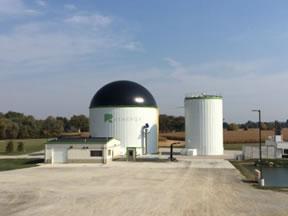 Renergy’s Emerald BioEnergy FacilityAnaerobic digestion produces two products: energy and fertilizer (digestate). Digestate is the material remaining after the anaerobic digestion of organic materials. Digestate can be separated into liquid and solid components that are land applied as a fertilizer. These products can be used on site reducing material costs or sold to others providing an additional revenue stream.
Renergy’s Emerald BioEnergy FacilityAnaerobic digestion produces two products: energy and fertilizer (digestate). Digestate is the material remaining after the anaerobic digestion of organic materials. Digestate can be separated into liquid and solid components that are land applied as a fertilizer. These products can be used on site reducing material costs or sold to others providing an additional revenue stream.
Ringler Farms energy company, Renergy, currently operates two anaerobic digesters. Their flagship bio-digester located in Central Ohio utilizes livestock manure to create renewable energy and nutrient-dense fertilizer. Ringler utilizes this natural fertilizer as a soil amendment to improve crop yield. The reuse of the digestate helps the farm’s energy company, Renergy Exit, meet its goals of environmental awareness and sustainable waste management.
See Stories from the Farm for more information.
Environmental Credits
Environmental credits are renewable energy credits (RECs, sometimes called renewable energy certificates) or carbon credits. These are tradable or quantifiable credits that represent generation of a specific amount of electricity (usually 1 megawatt) from renewable energy. RECs are often used by utilities to meet renewable portfolio standards (RPS) or other state standards requiring electricity providers to obtain a minimum percentage of power from renewable resources.
Brubaker Farm in Pennsylvania has a digester that produces more than 4 megawatts of electricity a day; equivalent to 150 to 200 homes usage. Brubaker Farm’s uses some of the electricity generated on the farm and at other Brubaker Farm locations; the rest is sold to the local power company. Under Pennsylvania’s Alternative Energy Portfolio Standard, the power company pays Brubaker Farm a premium for the renewable energy generated by the digester. Brubaker Farm has sold carbon credits based on methane emission reductions achieved from the anaerobic digester. The Brubaker family works with Vermont-based energy broker NativeEnergy, which specializes in farmer-owned, community-based renewable energy projects to sell carbon credits in a voluntary market. The farm also installed solar panels on the roofs of their barns and has also sold the solar RECs for that energy.
See Stories from the Farm for more information.

